“To study in Paris is to be born in Paris!”
« Étudier à Paris, c’est être né à Paris! »
― Victor Hugo, Les Misérables I, 3, ii
“Not a one of us has the honor of living a life that’s only his.
My life is yours, your life is mine, you live what I live; there is only one destiny.”
« Nul de nous n’a l’honneur d’avoir une vie qui soit à lui.
Ma vie est la vôtre, votre vie est la mienne, vous vivez ce que je vis ; la destinée est une. »
― Victor Hugo, Les Contemplations, Preface
The fourteen students who explored Paris with me through the works and life of Victor Hugo also took the opportunity to reflect on how their two-week study of Hugo in Paris affected them, with the able assistance of Lova Rajaonarisoa (click here for a preview of the course). The great majority of them adult students in the University of Virginia’s Bachelor of Interdisciplinary Studies (BIS) Program, they brought important life experiences with them. Here are a few of their takeaways:
 When I was accepted to the Victor Hugo Paris program, I had no way of knowing the immense impact Paris, and Hugo, would have on me. On https://www.marvabarnett.com/ is the Hugo quote “Let’s light up minds.” I can say unequivocally that my mind has been lit up from this experience. I knew France would be beautiful. I knew I would enjoy French culture. I was not prepared to feel transformed in every conceivable way. As I embraced Paris, Paris embraced me.
When I was accepted to the Victor Hugo Paris program, I had no way of knowing the immense impact Paris, and Hugo, would have on me. On https://www.marvabarnett.com/ is the Hugo quote “Let’s light up minds.” I can say unequivocally that my mind has been lit up from this experience. I knew France would be beautiful. I knew I would enjoy French culture. I was not prepared to feel transformed in every conceivable way. As I embraced Paris, Paris embraced me.
Over this course it became apparent that one of Hugo’s best and most impressive writing qualities is his ability to capture human emotion into words, especially two of  the strongest emotions: love and grief. For me, reading Hugo helped me heal in a way I never thought possible. I have changed in a way that I am unable to describe, but I’m sure Hugo could. I left Paris reminded to love wholly, and arrived in Virginia to the same message.
the strongest emotions: love and grief. For me, reading Hugo helped me heal in a way I never thought possible. I have changed in a way that I am unable to describe, but I’m sure Hugo could. I left Paris reminded to love wholly, and arrived in Virginia to the same message.
In true Victor Hugo form, I experienced the darkness and lightness of my emotions through my journey in Paris. And as a parting gift, I gained something that I would never have thought in this journey. It was the lasting connections that I have with the people in this class.
What led to these new understandings? Much delving into Hugo’s essays, novels and poetry (thanks to Robert F. Cook’s lively translations)—and intense engagement with site visits and a remarkable group of Hugo scholars.
 For our first class day, the president of the Society of the Friends of Victor Hugo, Arnaud Laster, offered an overview of Hugo’s key works and then guided us through central Paris in Hugo’s footsteps. M. Laster contradicted several misconceptions about Hugo, and our walk oriented the students to Parisian places that figure large in Hugo’s contributions—places we later visited at more length.
For our first class day, the president of the Society of the Friends of Victor Hugo, Arnaud Laster, offered an overview of Hugo’s key works and then guided us through central Paris in Hugo’s footsteps. M. Laster contradicted several misconceptions about Hugo, and our walk oriented the students to Parisian places that figure large in Hugo’s contributions—places we later visited at more length.
The students took advantage of our first Sunday with no official class meeting to act like Hugo: they took on the iconic Parisian role of flâneur / flâneuse, a person who strolls the city with a willingness to get lost, to turn away from any set destination and to observe all that surrounds her. As Hugo writes in Les Misérables [III, 1, 5], “To wander musing, that is to say, ‘flâner,’ is a good use of time for a philosopher . . . / “Errer songeant, c’est-à-dire flâner, est un bon emploi du temps pour le philosophe . . .” Some students were more enthusiastic about this activity than others, but, as it turned out, for many the experience was significant:
Paris taught me how to slow down. It was in the slowing down that I was able to recognize and experience the love and beauty that this city has to offer. . . . After my first day as a flâneuse, I was completely spellbound by Paris. It is a city that makes you want to fall in love, love yourself, and love the ones who love you even more.
Seeing Paris for the first time is a transformative experience. Of Hugo, I can now say I understand what he saw in Paris. This provocative city inspires us to observe life in action; to be present and enjoy small pleasures; to enjoy each moment you encounter; for flânerie to become a way of life.
Before our visits to the Sainte Chapelle and to the Conciergerie, where Hugo’s two sons were imprisoned in 1851 for exercising their freedom of speech and where Marie-Antoinette awaited execution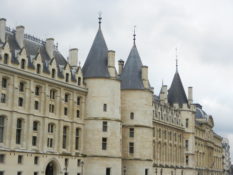 after the 1789 French Revolution, we studied excerpts from Hugo’s foundational essay “Rights and Law” and the beginning of his novella Le Dernier Jour d’un condamné / The Last Day of a Condemned Man. These works, along with excerpts from Les Misérables, resonated greatly with many students, as they wrote in their blog posts and final portfolio essays:
after the 1789 French Revolution, we studied excerpts from Hugo’s foundational essay “Rights and Law” and the beginning of his novella Le Dernier Jour d’un condamné / The Last Day of a Condemned Man. These works, along with excerpts from Les Misérables, resonated greatly with many students, as they wrote in their blog posts and final portfolio essays:
As we’re going through this course it feels almost like a puzzle. With each reading, with each discussion we uncover a little more and the final image gets clearer. One of my favorite lines was, “What is Right and what is Law: those are the two forces. From their agreement, order is born, and from their conflict, catastrophes.” I think about how this line is so clear and about how easily it can be applied to any form of government to see why certain laws work or not.
Exposure to Hugo’s ideas has changed my own stance on many social problems. For example, I had not strongly considered my position on the death penalty prior to this course and generally felt that if a crime were extreme enough, perhaps the punishment should be equally extreme. In that way, perhaps it might deter the worst of criminal offenses and relieve society of the burden of housing a violent criminal long term. However, Hugo’s views make a lot of sense. One wrong does not excuse another. By killing a criminal, we in some way stoop to that level.
After a quick Google search for “Countries that still use capital punishment,” I was shocked to find us on the list among countries like Indonesia, Pakistan, Bangladesh, Nigeria, Egypt, Iran, etc. It is sad that people were/are unable to see that capital punishment is simply just wrong. There is no crime that justifies the death of a person. The death penalty doesn’t offer a solution. This “eye for an eye” mentality only reinforces a vigilante-style justice for heinous crimes.
Notre-Dame Cathedral still exists in part because Hugo’s novel Notre-Dame de Paris  (The Hunchback of Notre-Dame) was instrumental in convincing people to preserve this majestic Gothic monument. Even before he wrote his novel starring the cathedral as the key character, Hugo had drafted an essay—“Guerre aux démolisseurs” / “I Declare War on Vandals!”—in
(The Hunchback of Notre-Dame) was instrumental in convincing people to preserve this majestic Gothic monument. Even before he wrote his novel starring the cathedral as the key character, Hugo had drafted an essay—“Guerre aux démolisseurs” / “I Declare War on Vandals!”—in  which he condemned anyone who damaged or destroyed beautiful old building and demanded that the French save their national heritage. We returned several times to this 1825 essay and to Hugo’s expanded 1832 version as we saw how his attention to medieval buildings had a decided impact on the Paris cityscape (in the case of the Tour Saint-Jacques, for instance, photo at left) and beyond (in the case of the Jumièges Abbey in Normandy [see below]). The tower was all that was left of the Saint-Jacques-de-la-Boucherie Church when Hugo wrote about such medieval buildings.
which he condemned anyone who damaged or destroyed beautiful old building and demanded that the French save their national heritage. We returned several times to this 1825 essay and to Hugo’s expanded 1832 version as we saw how his attention to medieval buildings had a decided impact on the Paris cityscape (in the case of the Tour Saint-Jacques, for instance, photo at left) and beyond (in the case of the Jumièges Abbey in Normandy [see below]). The tower was all that was left of the Saint-Jacques-de-la-Boucherie Church when Hugo wrote about such medieval buildings.
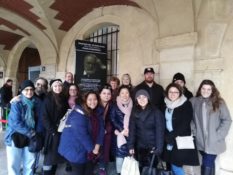 Over the next three days, we were regaled with Hugo’s original artwork, his imagination and energy as an interior decorator, his large correspondence, and his political importance as seen through caricatures of him throughout his life. Words cannot express my gratitude to the French scholars who so generously shared their expertise with us at the Maison de Victor Hugo and the Bibliothèque nationale de France.
Over the next three days, we were regaled with Hugo’s original artwork, his imagination and energy as an interior decorator, his large correspondence, and his political importance as seen through caricatures of him throughout his life. Words cannot express my gratitude to the French scholars who so generously shared their expertise with us at the Maison de Victor Hugo and the Bibliothèque nationale de France.
 Gérard Audinet is the Director of two Maisons de Victor Hugo: the Hugos’ Paris Place des Vosges residence (1832-48) and their exile home on the Channel Island of Guernsey at Hauteville House (1855-70). For his in-class presentation, M. Audinet introduced us to Hugo’s interior design of the Hauteville House public rooms. Then, after walking with us from our hotel near the Place de la Bastille to the Maison de Victor Hugo in the lovely Place des Vosges, M. Audinet gave us a personal tour of the Hugos’ apartment. Students expressed their appreciation at connecting with the Hugo family in portraits, at seeing the Chinese room that Victor had designed for his lover Juliette Drouet’s Guernsey home, and at visiting a re-creation of the room in which Hugo died in 1885.
Gérard Audinet is the Director of two Maisons de Victor Hugo: the Hugos’ Paris Place des Vosges residence (1832-48) and their exile home on the Channel Island of Guernsey at Hauteville House (1855-70). For his in-class presentation, M. Audinet introduced us to Hugo’s interior design of the Hauteville House public rooms. Then, after walking with us from our hotel near the Place de la Bastille to the Maison de Victor Hugo in the lovely Place des Vosges, M. Audinet gave us a personal tour of the Hugos’ apartment. Students expressed their appreciation at connecting with the Hugo family in portraits, at seeing the Chinese room that Victor had designed for his lover Juliette Drouet’s Guernsey home, and at visiting a re-creation of the room in which Hugo died in 1885.
Michèle Bertaux—Specialist in Manuscript Letters and also in charge of the Maison de Victor Hugo research library—brought Hugo to life through his correspondence,  personal journals and drawings, which she brought from storage especially for us. We also exclaimed over the quill pens that Hugo used to write Les Misérables, as well as the inkwell from which sprung his epic poetry collection La Légende des siècles / The Legend of the Centuries. Students were struck by the vast quantity of letters that Juliette wrote to Victor (over 22,000) (to see samples of Juliette’s drawings and her writing, click here; to read transcripts of her letters, click here).
personal journals and drawings, which she brought from storage especially for us. We also exclaimed over the quill pens that Hugo used to write Les Misérables, as well as the inkwell from which sprung his epic poetry collection La Légende des siècles / The Legend of the Centuries. Students were struck by the vast quantity of letters that Juliette wrote to Victor (over 22,000) (to see samples of Juliette’s drawings and her writing, click here; to read transcripts of her letters, click here).
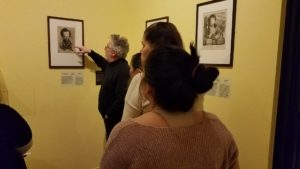 Vincent Gille—Curator at the Maison de Victor Hugo in charge of the exhibit “Hugo à la Une!”—treated us to a personal tour of the exhibition, during which M. Gille not only introduced the students to the ways in which nineteenth-century caricaturists emphasized Hugo’s high forehead and stern political demeanor, but also expanded my understanding of the ways in which the right-wing press expressed their anger at and frustration with Hugo’s often progressive stances.
Vincent Gille—Curator at the Maison de Victor Hugo in charge of the exhibit “Hugo à la Une!”—treated us to a personal tour of the exhibition, during which M. Gille not only introduced the students to the ways in which nineteenth-century caricaturists emphasized Hugo’s high forehead and stern political demeanor, but also expanded my understanding of the ways in which the right-wing press expressed their anger at and frustration with Hugo’s often progressive stances.
Thomas Cazentre welcomed us to the beautifully renovated Bibliothèque nationale de France / French National Library, where he is Curator of Modern and  Contemporary Manuscripts, including the Victor Hugo collection of manuscripts and artwork. M. Cazentre kindly spent his morning showing us Hugo’s bound manuscript of Les Misérables (which rarely leaves its repository) and dozens of Hugo’s drawings—from the
Contemporary Manuscripts, including the Victor Hugo collection of manuscripts and artwork. M. Cazentre kindly spent his morning showing us Hugo’s bound manuscript of Les Misérables (which rarely leaves its repository) and dozens of Hugo’s drawings—from the caricatures he did to amuse himself and his children, to his travel journals with detailed chateaux and ruins. Hugo also experimented with media (painting with coffee and coffee grounds, for example) and created fantastical scenes and beasts after dipping lace in ink, pressing it onto paper and working from there .
caricatures he did to amuse himself and his children, to his travel journals with detailed chateaux and ruins. Hugo also experimented with media (painting with coffee and coffee grounds, for example) and created fantastical scenes and beasts after dipping lace in ink, pressing it onto paper and working from there .

The students found these visits to be particularly powerful in bringing to life Hugo, the man, the writer and the artist:
Seeing the drawings, notebooks, and manuscripts of Victor Hugo at the French National Library today was incredible. . . . I also found Thomas Cazentre to be fascinating. He has such a wealth of information on and such insight into the documents he is helping to preserve.
The Les Misérables manuscript with all of Hugo’s edits was such an astonishing thing to see. Being able to actually see the pages gave me an even greater appreciation for the hours he labored over loose leaf pages handwriting this incredible story.
 I thought of how fortunate that I, an ordinary student, was to be sitting here a mere few feet away from the actual handwritten
I thought of how fortunate that I, an ordinary student, was to be sitting here a mere few feet away from the actual handwritten  work of Victor Hugo, and that we all were fortunate that Hugo had the foresight to take the necessary precautions to preserve his work for future generations.
work of Victor Hugo, and that we all were fortunate that Hugo had the foresight to take the necessary precautions to preserve his work for future generations.
Day 5 in Paris and I am still feeling disconnected from Victor Hugo until we visit the Maison de Victor de Hugo with Gérard Audinet. I became particularly intrigued when M. Audinet mentioned that the museum has rooms dedicated to when Hugo was in exile . . . . As I walked up the staircase, I noticed the portrait photographs of Hugo taken from when he was a young man to when he was age 72. For some reason the Hugo photographs and being in his former home made me feel as if I were traveling back to 1832.
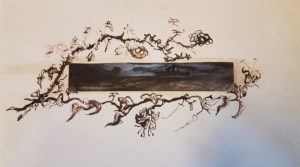
 To prepare for these visits so rich in insights into Hugo the man, we had read a sampling of his poems and letters to his wife, Adèle (portrait to the left), his children, his lifelong lover, friend
To prepare for these visits so rich in insights into Hugo the man, we had read a sampling of his poems and letters to his wife, Adèle (portrait to the left), his children, his lifelong lover, friend  and muse, Juliette Drouet (portrait to the right), and his shorter-term lover, Léonie d’Aunet Biard. I was impressed with my students’ ability to put their American cultural assumptions aside in order to open their minds to other cultural norms around love affairs and to Hugo’s broad capacity for love, as expressed, for instance, in this excerpt from a student’s portfolio:
and muse, Juliette Drouet (portrait to the right), and his shorter-term lover, Léonie d’Aunet Biard. I was impressed with my students’ ability to put their American cultural assumptions aside in order to open their minds to other cultural norms around love affairs and to Hugo’s broad capacity for love, as expressed, for instance, in this excerpt from a student’s portfolio:
When we studied the letters that Hugo wrote to Adèle, Juliette, and Léonie, I could not help but feel his emotion through the letters. His compassion and benevolence are very evident in his writing.
On Saturday morning, we headed away from the gilets jaunes / yellow vest demonstrations (of which Hugo may well have approved) to the beautiful Père-Lachaise cemetery. Hugo and his friends and family were there on March 18, 1871, for his son Charles’s funeral. Coincidentally, that same morning the short-lived Paris Commune government was declared in opposition to the official government. The National Guard troops in Paris, made up mostly of poor people and politicized, supported the Commune. Despite the threat of fighting in the area, the National Guard recognized Victor Hugo and gave him and the cortege safe passage to the gravesite.
 To prepare for our visit, we studied Hugo’s May 22, 1876, Senate speech arguing for amnesty for the Communards who had been imprisoned or exiled to New Caledonia after their defeat. Once at the cemetery, we stopped to remembe
To prepare for our visit, we studied Hugo’s May 22, 1876, Senate speech arguing for amnesty for the Communards who had been imprisoned or exiled to New Caledonia after their defeat. Once at the cemetery, we stopped to remembe r the massacre of the remaining Communards at the end of the Bloody Week / la Semaine Sanglante at the Communards’ Wall / le Mur des Fédérés. Before exploring on our own, we visited the Hugo burial plot where many of Hugo’s family members are interred (photo of stele at right).
r the massacre of the remaining Communards at the end of the Bloody Week / la Semaine Sanglante at the Communards’ Wall / le Mur des Fédérés. Before exploring on our own, we visited the Hugo burial plot where many of Hugo’s family members are interred (photo of stele at right).
Our next readings and visits had a very different tone as the students got to know Marius when he fell in love with Cosette in the Jardin du Luxembourg in Les Misérables. Our study of Hugo’s poetic vision of nature and love in his epic novel touched several students, who found that Hugo and Paris together renewed their love of love. As one student wrote:
 My favorite reading thus far was “The Conjunction of Two Stars”—I thoroughly enjoyed the Romantic side of Hugo. As mentioned in class, I believe this story is a reflection of not only personal, emotional and physical growth for Cosette, but for Marius as well. This excerpt (Book 6) is a great example of the Romantic movement which has an emphasis on emotion and individualism . . . . Our visit to the Jardin du Luxembourg was a great addition to the beauty of Hugo’s stories that take place in the gardens.
My favorite reading thus far was “The Conjunction of Two Stars”—I thoroughly enjoyed the Romantic side of Hugo. As mentioned in class, I believe this story is a reflection of not only personal, emotional and physical growth for Cosette, but for Marius as well. This excerpt (Book 6) is a great example of the Romantic movement which has an emphasis on emotion and individualism . . . . Our visit to the Jardin du Luxembourg was a great addition to the beauty of Hugo’s stories that take place in the gardens.
Personally, I reveled in learning new information from my Hugolian colleagues. Perhaps most fascinating for me was Jean-Marc Hovasse’s story of the beautiful, enormous birthday party given to Hugo as he entered his eightieth year on Sunday, 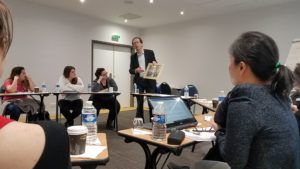 February 27, 1881. M. Hovasse is the author of Hugo’s definitive biography (with Fayard) and Director of Research at the CNRS (Centre national de la recherche scientifique. He brought to life for us this day-long parade and festival on the street where Hugo lived, recounting how those events prefigure the immense recognition granted to Hugo during his national funeral after he died on May 22, 1885.
February 27, 1881. M. Hovasse is the author of Hugo’s definitive biography (with Fayard) and Director of Research at the CNRS (Centre national de la recherche scientifique. He brought to life for us this day-long parade and festival on the street where Hugo lived, recounting how those events prefigure the immense recognition granted to Hugo during his national funeral after he died on May 22, 1885.
Throughout the grey, cold Sunday, half a million people paraded from the Arc de Triomphe to the Hugos’ home on rue Eylau: people of all ages and walks of life, including schoolchildren who offered Hugo bouquets. Massive numbers of flowers had been shipped to Paris. As journalist Gustave Rivet reported for Le Rappel, “Marvelous bouquets arrive from the South, from Nice or Toulon. One of them is made completely of forget-me-nots, with these words in red flowers: ‘To Victor Hugo.’” That same day, the government commemorated Hugo by renaming his part 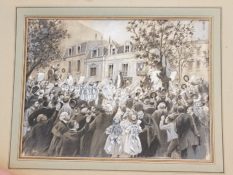 of the street “avenue Victor Hugo,” a name that today applies to the avenue’s entire length. Hugo shook hands with some of his admirers. Then, flanked by his grandchildren, Georges and Jeanne, he waved from his second-floor window, hearing over and over again “Vive Victor Hugo!” / “Long live Victor Hugo!”
of the street “avenue Victor Hugo,” a name that today applies to the avenue’s entire length. Hugo shook hands with some of his admirers. Then, flanked by his grandchildren, Georges and Jeanne, he waved from his second-floor window, hearing over and over again “Vive Victor Hugo!” / “Long live Victor Hugo!”
Through their reading, the students were able to compare this birthday celebration with the long mourning process for Hugo at his death four years later. Before our visit to the Panthéon, we learned how the French government decided to deconsecrate the Église Sainte-Geneviève in order to rename it the Panthéon and dedicate it to the memory of extraordinary French people. Victor Hugo was entombed there on June 1, 1885, 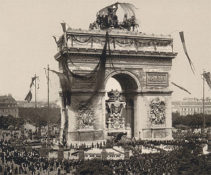 after his body had lain in state overnight in a huge catafalque under the Arc de Triomphe. (When we climbed it in a strong wind, the crowd shown in the photo at left was no longer there.) Hugo—who had asked that in his last will and testament that his funeral be treated like that of a poor person—was celebrated by at least a million people. M.
after his body had lain in state overnight in a huge catafalque under the Arc de Triomphe. (When we climbed it in a strong wind, the crowd shown in the photo at left was no longer there.) Hugo—who had asked that in his last will and testament that his funeral be treated like that of a poor person—was celebrated by at least a million people. M.  Hovasse also gave us an intimate view of how sculptor Auguste Rodin observed Hugo in order to create sculptures which we later saw at the Musée Rodin.
Hovasse also gave us an intimate view of how sculptor Auguste Rodin observed Hugo in order to create sculptures which we later saw at the Musée Rodin.
To give students who had never visited a France a taste of the French countryside and insight into Hugo’s greatest tragedy, we spent our penultima te day traveling to Normandy in the company of Gérard Pouchain—who is not only a Hugo scholar but also co-author of the definitive biography of Juliette Drouet. We took full advantage of the sunny day, visiting first the ruined Jumièges Abbey, west of Rouen. During Hugo’s time, the Abbey was being decimated: it had become a rock quarry for new buildings. As Hugo wrote when he was 23, “We were told that Englishmen had bought for three hundred Francs the right to pack up whatever they liked among the debris of the admirable abbey of Jumièges.” Along with other Romantics, Hugo appreciated the abbey’s Romanesque history and worked on several Paris commissions to help preserve France’s architectural heritage.
te day traveling to Normandy in the company of Gérard Pouchain—who is not only a Hugo scholar but also co-author of the definitive biography of Juliette Drouet. We took full advantage of the sunny day, visiting first the ruined Jumièges Abbey, west of Rouen. During Hugo’s time, the Abbey was being decimated: it had become a rock quarry for new buildings. As Hugo wrote when he was 23, “We were told that Englishmen had bought for three hundred Francs the right to pack up whatever they liked among the debris of the admirable abbey of Jumièges.” Along with other Romantics, Hugo appreciated the abbey’s Romanesque history and worked on several Paris commissions to help preserve France’s architectural heritage.
 After lunch overlooking the Seine at La Marina in Caudebec, we headed to Villequier, where Hugo’s daughter Léopoldine’s in-laws had lived. There Léopoldine—together with her hus
After lunch overlooking the Seine at La Marina in Caudebec, we headed to Villequier, where Hugo’s daughter Léopoldine’s in-laws had lived. There Léopoldine—together with her hus band, Charles Vacquerie, and two of his family members—drowned in a tragic boating accident on September 4, 1843, when Léopoldine was only nineteen. Before visiting the Maison Vacquerie – Musée Victor Hugo, we looked out at the curve in the Seine where the accident had happened (see photo at upper left) and visited the graveyard where Léopoldine and Charles were buried together, alongside family members.
band, Charles Vacquerie, and two of his family members—drowned in a tragic boating accident on September 4, 1843, when Léopoldine was only nineteen. Before visiting the Maison Vacquerie – Musée Victor Hugo, we looked out at the curve in the Seine where the accident had happened (see photo at upper left) and visited the graveyard where Léopoldine and Charles were buried together, alongside family members.
 Many were moved when M. Pouchain and I recited two of Hugo’s Les Contemplations poems in memory of Léopoldine (in French and then in English): Hugo’s bittersweet poem for Léopoldine’s wedding day and his renowned “Demain, dès l’aube . . .” / “Tomorrow, at dawn . . .,” Hugo’s deceptively, exquisitely simple French poem about traveling to his daughter’s grave.
Many were moved when M. Pouchain and I recited two of Hugo’s Les Contemplations poems in memory of Léopoldine (in French and then in English): Hugo’s bittersweet poem for Léopoldine’s wedding day and his renowned “Demain, dès l’aube . . .” / “Tomorrow, at dawn . . .,” Hugo’s deceptively, exquisitely simple French poem about traveling to his daughter’s grave.
At the museum, we deepened our understanding of the Hug o family as we visited with director Marie-Jean Mazurier the country house filled with Hugo memorabilia and perused the exhibition about Hugo as poet and statesman during France’s Second Republic.
o family as we visited with director Marie-Jean Mazurier the country house filled with Hugo memorabilia and perused the exhibition about Hugo as poet and statesman during France’s Second Republic.
Victor Hugo was known to walk for hours around Paris and to observe and muse as he went. The city had such an impact on him that he carried it in his mind during his nineteen years in political exile and embedded it throughout Les Misérables. And, as we have seen, Hugo had an impact on the physical reality of Paris. We dedicated our final class day to students’ presentations about the impact Hugo and Paris had had on them, which was also the subject of their final portfolios. Let’s give the students the final word:
Hugo encourages his audience to open their eyes and hearts to the magic and beauty of life that is all around them. This is something that I intend to take with me throughout life. I want to see and feel all the beauty that exists around me.
For me, our journey with Victor Hugo has opened the floodgates of introspection and has me intensely focused on the questions of our souls. Discovering Hugo as the person he was behind the pages has given even deeper meaning to his words. If I had to describe what makes Hugo so special, it is that his words don’t instruct us how to feel or think, but rather they incite us to think, to feel, and to contemplate our deepest questions.
I found this experience rewarding, but challenging as I struggled to find a connection to Victor Hugo. This experience has taught me that learning is more than just observing, memorizing, and summarizing. Rather, learning with a purpose, finding a connection, and thinking and reflecting on what I learned are new skills that the BIS program is teaching me.
As I stated in my application for the program, I wanted to go on this trip for the experience, the stories I could tell and because the musical has always been my favorite. But I never could have imagined the impact this class and Hugo has and will continue to have on me.
A student’s photo montage: Reflections of Victor Hugo’s Paris

